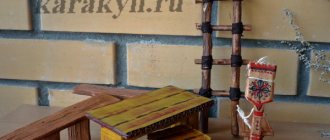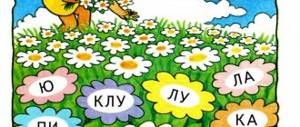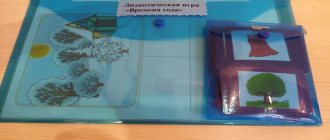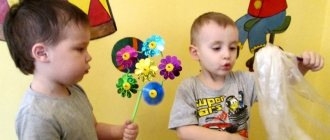Sound House | Department of Education of the Rasskazovo City Administration
Content
Exhibition participant
Educator: Taisiya Ivanovna Medvedeva
MBDOU "Kindergarten No. 6 "Tsvetik" Didactic manual "Sound House"
Didactic manual “Sound House”
Didactic manual “Sound House”
This didactic manual is intended for children 5-6 years old.
Target:
Development of phonemic and speech hearing in children, formation of orientation in the sound system of language.
Tasks:
- Teach sound analysis of words;
- Determine the sequence of sounds in a word;
- Give an idea of the sounds of vowels and consonants, their differences from each other
pronunciation friend;
- Teach to distinguish between hard and soft consonants by ear and hearing
articulation;
- Instill the skill of denoting sounds with conventional icons;
- Develop coherent speech, enrich vocabulary.
Description of the manual
The “Sound House” manual is made of thick cardboard and can be easily transported to a convenient place to work with it. It can be placed, laid down, hung. The inhabitants of this house are sounds.
On the roof of the house there are pictures depicting an object whose name consists of three, four, five sounds and which the child must analyze. The pictures are changed and fixed using clamps.
There are small windows on the wall. Their number corresponds to the number of sounds in the word denoting the name of the object in the picture.
A fishing line is attached to the house for hanging cage windows on it. One sound settles in each window. It is indicated by a chip card:
vowel sound - red chip - card;
hard consonant sound - blue chip - card;
soft consonant sound - green chip - card.
The door of the house serves as a pocket in which all the chips - cards - are located.
By playing with the residents of the house, children learn to hear sound. They establish the sequence and number of sounds in a given word, give them a full description, call the sound in the specified window by name, merge sounds, determine the position of the sound in the word, “introduce” sounds only into their own window and “evict” them at the command of the players, they count Which sounds are more or less, replace one sound with another.
This manual improves the child’s auditory perception and teaches how to conduct sound analysis of words.
Print version: MBDOU “Kindergarten No. 6 “Tsvetik” - Taisiya Ivanovna Medvedeva - Didactic manual “Sound House”
rasskazovogorono.68edu.ru
"Houses for sounds." Didactic manual on teaching literacy for the preparatory group
Goal: to form sound analytical-synthetic activity as a prerequisite for learning to read and write.
Objectives: to learn to determine the presence of given sounds in words and to differentiate sounds by hardness - softness, to develop phonemic hearing, attention, memory, logical thinking, to cultivate interest in speech creativity.
Complete set: playing field, cube with chips, green and blue houses, object pictures (only consonant letters are used in the game, which denote two oppositional sounds that have differences in hardness and softness.
Rules of the game:
Option 1.
Children are given several cards. The adult sets the order. The child names his picture, highlighting the first sound in the word, gives it a characteristic, and places a card on the house that corresponds to the soft sound (green house) or hard sound (blue house). If someone makes a mistake, then the card remains with him.
Option 2.
Each child is given several cards (2,3...) and one chip. Everyone places their chips at the beginning of the track. Everyone takes turns throwing the dice and moving around the circles in which the letters are written as much as the dice shows. Having settled on a letter, the child names it and says what sounds it can represent. Then the child looks among his pictures for those whose names begin with these sounds. If there is such a picture(s), the child places it (them) on the image of the corresponding house: blue or green. The first one to free himself from the pictures wins.
Option 3
Everyone places their chips at the beginning of the track. Everyone takes turns throwing the dice and moving around the circles in which the letters are written as much as the dice shows. Having settled on a letter, the child comes up with a word for the dropped letter: with a soft consonant if the circle around the letter is green and with a hard consonant if the circle around the letter is blue. The winner is the one who reaches the end of the field faster and names the words correctly. If the word is coined incorrectly, the child misses a turn.
dohcolonoc.ru
Fun Velcro Letter Houses
The developmental didactic manual Carpet Designer Houses for Letters with Letters is an excellent opportunity to teach your child to distinguish vowels and consonants in an interesting way and to remember letters. The figures are easily attached to the houses using Velcro. The game has been successfully used in kindergartens for a long time.
Carpet designer - realism and quality:
- the material is very dense and high quality, does not tear, does not wrinkle, does not lose shape;
- gluing and painting – handmade;
- reusable Velcro;
- realistic, easily recognizable elements.
The set includes:
- 4 houses;
- inscriptions Vowels, Consonants;
- letters 36 pieces;
- 2 wood, 3 grass elements, 3 clouds.
How to play?
Place the letters in the correct houses: vowels and consonants. You can do this in turns, you can arrange a competition among the children, give each one a house to see who can fill theirs the fastest. Or an adult shows a letter - whoever guesses correctly first takes it. You can also ask about consonants: voiceless-voiced, about vowels: one sound or two.
Letters come to visit
Let's start learning to read. Bring the vowel letter to visit the consonants, let it sing a song paired with each of them. Then, on the contrary, some consonant goes to the vowels in the house. Encourage your child to choose a letter on their own to increase interest in the activity.
It's starting to rain!
A fun game for remembering letter names. We take a few letters and let them out to play on the grass. We pronounce the names of everyone. Next we will attach a cloud, symbolizing the beginning of rain. And now we begin to call the letters to the house by name: “Letter A, run home, it’s starting to rain.” The child will help with the letters. Change places.
Magic story
We tell a story by adding words made from letters. This can be either a well-known fairy tale or an invented plot. For example, a chicken laid an EGG. The word egg must be completed and written by the child.
Right or wrong
Playing teacher. We post words with mistakes that are funny and understandable to the child: instead of SUP - SIP, let him try to correct them.
liplip.club
Lesson 7
.Free quota operation: how to get it and what’s changing in 2019 |
How to do IVF for free under compulsory medical insurance: what documents are needed
Detskiy sad.Ru >> Electronic library >> Family and children >> Education in kindergarten >> Source: Zhurova L. E. “Teaching literacy in kindergarten” Publishing house “Pedagogics”, M., 1978 OCR Detskiysad .Ru
Software content. Introduce children to the sound structure of a word; teach how to pronounce a word slowly, emphasizing the sound indicated on the diagram; pronounce the word in accordance with the movement of the pointer according to the diagram.
Material for the lesson. 1. Board, pointer, chalk. 2. A special board for working in literacy classes. 3. Each child has a card with a picture of a poppy and a diagram of the sound composition of the word, a pointer (counting stick). 4. A large table with a picture of a poppy and a diagram of the sound composition of the word.
Progress of the lesson
Educator. How many of you have been to the forest? Have you all been? Wonderful! Who has ever gotten lost in the forest? Nobody? This is even better! It must be very scary to be alone in the forest, right? And when we pick berries, how do we call each other so as not to get lost? That's right, you can shout Tanya or Vova. But there is one word that you can shout in the forest, and everyone will know that someone wants to check if his friends are nearby, if he is not left behind, if he is left alone. What kind of word is this, how many of you know? Yes, that word is au. A short word, but it is very necessary in the forest; it has helped many people out of trouble and prevented them from getting lost. Let's play with you. Let's imagine that we went into the forest. One group of guys went behind the trees and couldn’t see where the others were. This will be the first row. So they consulted among themselves and decided to call the other guys and shout out to them. Try it, shout out in unison. No, you didn't do a very good job! You need to stretch out this word, stretch out every sound in it so that it can be heard far away. Let's try it again: ahhhhh. Now it’s much better, call me one more time: aaaaaaaaaaaaaaaaaaaaaaaaaaaaaaah Fine! And the rest of the guys - this is the second row - heard their comrades calling them loudly and drawn-out, they were glad that they were not lost, but here, not far away, and answered them in the same drawn-out chorus: a-a-oo-o. You did it right right away! You can hear it throughout the forest, now no one will get lost. Shout again: a-a-oo-oo! Well done! Now answer me this question: when we shout ay, what sound do we pronounce first in this word? What do you think, Lena? Do you think so, but what does Vova think? (The teacher calls 3-5 children.) Everyone thinks that the first sound in the word ay is ay? That's right, I think so too. Now we will denote this sound on the board with a square (the teacher draws a square on the board with chalk). What sound did we designate, Sasha? Sasha. First. Educator. Yes, it comes first in the word au, but what is the sound itself? Sasha. A. Educator. Fine. This is how we depicted the sound a. Well, what is the second sound in the word au-u-u? Who heard him? Kostya. U. Educator. That's right, the second sound in the word ay is u. Here we will draw a second one next to the first square. What sound is that, Vera? (The teacher points to the second cell with a pointer.) Faith. U. Educator Correct! What sound is that, Tanya? (Points to the first cell with a pointer.) Tanya. This is the sound of a. Educator. You answered very well, clever girl (so, pointing with a pointer first to the first, then to the second cell, he interviews several children). And now this is your task: I will slowly lead with a pointer from the first cell to the second, and you pronounce the sound in which cell my pointer is located (leads the pointer from left to right along the cells, the children say in chorus together with the teacher a-a-a-u -y). Valerik, my pointer is still in the first box, and you’re already talking, you’re in a hurry. Be careful! Now everything is good, correct (repeat the word 3-4 times). I wonder which row speaks better for us? Please, first row (leads with a pointer, but silently); and now the second row (silently leading with a pointer). Both rows spoke very well, as if with my pointer, no one was in a hurry and did not lag behind. And who wants to say one? (Calls two or three children. The child speaks from his seat in accordance with the direction. If a well-prepared child is called, he does not need the help of a teacher. But this task is not difficult, it has already been completed several times, so you can call less prepared children.) Here I am I heard how well Galochka spoke in her row. She never fell behind or ran ahead. Come here, Galya, let's show all the kids how to speak correctly, let them learn from you. Well, start (the teacher leads with a pointer and pronounces ay together with Galya). Well done! Everyone learned to say the word au exactly with my pointer. Now look at the picture I have here (turns over the table with a poppy that was previously hanging with a picture on the wall). What is this? Children. Poppy. Teacher, Yes, it's a poppy. A very beautiful flower, isn't it? Look: under the poppy there are exactly the same squares as those we drew on the board for the word au. Who can guess what these cells mean? Seryozha. These are boxes for planting flowers. Educator. This is how Seryozha decided. No, he thought wrong. These cells are not boxes. What did the squares on the board mean? (Points with a pointer to the diagrams of the word ay.) Alyosha. Sounds were indicated. Educator. Yes, these two cells denoted the sounds in the word ay, right? In what word do these cells represent the sounds? (Points with a pointer to a diagram of the sound composition of the word poppy.) Kostya. In the word poppy. Educator. Very good! Kostya said correctly: these cells indicate how many sounds there are in the word poppy. How many cells are there? Have you counted, Olya? How many? What about you, Sasha, and Seryozha? (Calls 5-7 children from their place.) Did everyone get three squares? So, how many sounds are there in the word poppy? Yes, three. Remember. This will be our secret: how many cells are drawn under the picture, that means there are so many sounds in this word. Now let's try to pronounce the word poppy together with my pointer, the way you said the word ay. Look, I’ll tell you first: poppy (at the same time he leads the pointer along the diagram of the sound composition of the word). Now let's all speak in chorus together with my pointer (say in chorus 2-3 times, while the teacher listens very carefully to see if any of the children are in a hurry). Well done! Now the first row will speak quietly but clearly. Please: poppy. Great! And the second row will speak loudly, but, look, take your time, just like with a pointer. Well done! Who wants to come to the board and say for themselves? (Calls 2-3 children.) Now take the cards on your table and turn them over. What's drawn there? Children. Poppy. Educator. Yes, and just as beautiful as on the big table. And on your trays you have small pointers. Take a pointer in your hand. In your right hand, Verochka! And let's try to do this: I will pronounce the word, and you point the pointer along the cells. On a large table, I pointed with a pointer, and you spoke, but now let’s do the opposite: I will speak, and you guide with a pointer. Get ready, listen to me carefully: poppy (the teacher must find a place for himself in the group in order to see the actions of all the children. The children’s patterns are quite large, so you can control the correctness of the child’s actions from a fairly large distance). You did very well. Kostya’s pointer, however, was in a hurry, and Valerik’s too, but Ira’s and Alyosha’s were a little behind. But, of course, it’s difficult to learn this the first time. Let's try again. M - Kostya, I’m only saying the first sound, but your pointer is already in the third square! Do not rush! Let's do it again: poppy. Much better already! Well, one more time (repeat this three or four times). Svetlana did very well. She will now come to the board and say the word poppy instead of me, and you will lead her with a pointer. Begin, Sveta: poppy (the teacher helps Sveta in a low voice). Well done! Now Andryusha will go to the board. But remember, you must speak loudly and clearly so that everyone can hear you (so call three or four people, including poorly prepared ones). You did very well today. We learned to say a word in accordance with the movement of my pointer, but it’s difficult! I'm very pleased with you. Well done!
Manual 'House of Letters'
Methodological development: Manual “House of Letters” for the development of phonemic processes in preschool children. Abstract: The development of phonemic processes is a necessary condition for the correction of sound pronunciation and a prerequisite for successful literacy acquisition. A good assistant for a speech therapist in this work can be the “Letter House” manual, which creates a playful situation during the lesson and stimulates children’s activity.
The development of phonemic processes is a necessary condition for the correction of sound pronunciation and a prerequisite for successful literacy acquisition. A good assistant for a speech therapist in this work can be the “Letter House” manual, which creates a playful situation during the lesson and stimulates children’s activity.
Description. The manual is a House with a rectangular hole cut in one of the windows. The size of the hole should be such that the child can easily put the picture into it. Above the window there is a plastic pocket - a “balcony”, into which the letter is inserted. The back of the roof is attached to the House using Velcro and folds back when you need to get the pictures.
The house can be used to teach children the following skills:
1) Determining the presence of a sound in a word.
Children are asked to choose “letter gifts” from a set of pictures and place them in the window. The letter “likes” only those gifts that begin with its sound. (Options: end with a given sound, the sound is in the middle of the word)
2) Differentiation of hard and soft consonants.
If there is a letter on the balcony “in a blue dress”, we select words with a hard sound, if in green - “with a soft sound”.
3) Syllable analysis of a word, determination of a stressed syllable.
Children are asked to choose pictures with a certain number of syllables or with a certain stressed syllable (a syllable diagram is placed on the balcony).
4) Sound analysis of the word.
Children are asked to choose pictures that correspond to a specific sound pattern.
In each case, in addition to choosing pictures, it is useful to invite children to come up with a word and draw their own picture.
Children who can read and write can put a card with a written word in the window. Children who have not firmly grasped the image of a letter can be asked to draw and give the letter its portrait.
As an example, we give a plan for a speech therapy lesson in a middle group using the “Letter House”.
Topic: “Sound and letter A.”
1. Introducing the letter A. The letter appears from the house and is placed on the balcony. 2. Introduction to sound A. Characteristics and articulation of sound. 3. Isolating a sound from a series of vowels. Game "Clap your hands when you hear A." 4. Determination of the first vowel sound in a word. Selection of pictures for sound A. Game “Give a gift to a letter.” Children put pictures in the house. 5. Dynamic pause. 6. Recalling words starting with sound A. “What’s in the house?” 7. Development of mental processes (memory, attention). Games with pictures “What’s missing? What changed?" 8. Work on syllable structure. Clap picture names syllable by syllable. 9. Development of phonemic representations. Independent selection of words for the sound A. “Come up with and draw a picture for the letter.” Children put their drawings into the house. 10. Completion of the lesson. Letter A praises the children and hides in the house.
According to our observations, children are attracted both by the play situation and by the process of lowering pictures into the window of the house. Work organized in this way increases the desire to find the right picture, choose a word on your own, and increases children’s interest in the activity as a whole.
Lyulina A.K., teacher-speech therapist
Loading...
logoportal.ru
Introducing the letter E
It is better to start getting acquainted with the letter E by searching for the letter in the large alphabet. If you succeed the first time (preschoolers already know the previous letters), you can move on. Otherwise, you should help the children with a preparatory, simple poem:
We glue the sticks to the line: One, two, three... and the letter E. The letter E will remind us of the three-pronged comb. (Rein S.)
After listening to such a description, the children will easily find the letter E. It will be good if the children learn this poem by heart in order to better remember and pronounce the desired sound once again. For greater effect, combine repeating the poem with watching an interactive video.
The next stage of learning is to look at a sample of writing a letter. You can write down the desired symbol individually with each child or on the board for the whole group (this is how we teach children independence).
The letter has been studied, children can already distinguish it from others. The next task is to explain to them that E is spelled differently. The simplest and most proven way of explanation is the example of a family, where the large printed E is the father (the head of the family), the large capital E is the mother, and the small “e” is their child.









